Metal Sequestrant Calculator for Pools
Published on: April 19, 2025 | Last Updated: April 13, 2025
Written By: Lila Fairholme
Metal sequestrants help prevent stains and discoloration in pools by binding to metals in water. Use this calculator to determine how much sequestrant you need. It works for both new treatments and maintenance doses. You’ll need to know your pool volume and current metal levels.
Metal Sequestrant Calculator
How to Use
- Measure your pool’s total water volume
- Test current metal levels with test strips
- Enter your target metal level (usually 0-0.3ppm)
- Check your sequestrant product’s strength
Always test water after treatment. Heavy metal levels may require multiple doses.
Crucial Winterizing Products
"The all-in-one solution for a guaranteed clear spring opening."
All-in-One Closing Chemical Kit
Winter demand is high - check stock
"The 'set & forget' option. This is the easiest winterizing I've ever done."
Simple 3-in-1 Winterizing Balls
Winter demand is high - check stock
"Invest once to protect your liner and prevent a swamp in the spring."
Heavy-Duty Winter Pool Cover
Winter demand is high - check stock
Factors Influencing Metal Sequestrant Effectiveness in Pools
Metal sequestrants work by binding to dissolved metals like iron, copper, and manganese. This prevents staining, scale formation, and cloudy water. Their performance depends on four key variables: pool test strips specifically designed for metals can be helpful in monitoring the levels of these metals in your pool. By using these, you can ensure your water stays clear and safe.
Metal Type and Concentration
Different metals require specific chelation strengths. Iron (0.2-0.3 ppm) often causes reddish-brown stains. Copper (0.3-0.4 ppm) creates blue-green discoloration. Manganese (0.1 ppm) produces black or purple streaks. High concentrations (>1 ppm) may demand shock treatments or drain/refill cycles before applying sequestering agents. Pool maintenance involves more than just addressing stains. Using stainless steel pool chemicals can enhance water clarity and protect equipment from corrosion.
Ph and Alkalinity Levels
Most sequestrants operate optimally within pH 7.2–7.8. At higher pH levels (≥8.0), metals precipitate faster than the agent can bind them. Total alkalinity (80–120 ppm) stabilizes pH fluctuations. Use a calcium saturation index calculator to balance calcium hardness (200–400 ppm) and temperature. Maintaining the proper calcium saturation index is important for preventing scale formation. A balanced calcium saturation index helps ensure water clarity and equipment longevity.
Water Temperature and Circulation
Cold water (<65°F) slows chemical reactions. Heated pools (>85°F) accelerate metal oxidation. Ensure even distribution by running the pump for 4–6 hours post-application. Target dead zones like steps or corners with a brush.
Existing Scale or Staining
Sequestrants prevent new stains but don’t remove existing ones. For severe cases, pair with ascorbic acid treatments (30–50 ppm) or citric acid soaks. Always test metal levels after stain removal to determine sequestrant dosage.
Types Of Metal Sequestrants for Swimming Pools
Not all sequestering agents work identically. Choose based on your pool’s metal profile:
Phosphonate-based Formulas
HEDP (1-Hydroxyethylidene-1,1-Diphosphonic Acid) dominates this category. Effective against iron and calcium scaling. Dosage: 8–16 oz per 10,000 gallons weekly. Brands: ProTeam Metal Magic, Jack’s Magic Purple Stuff. It’s important to keep your pool water clear and free of algae. Using an algaecide pool dose calculator can help you determine the right amount of algaecide needed for your specific pool size.
Polyacrylate Polymers
Target copper and manganese. Often combined with phosphonates for broad-spectrum protection. Look for 20–30% active polymer content. Example: SeaKlear Metal Defense.
Citric Acid and Gluconate Blends
Ideal for saltwater pools or those with low pH tolerance. Biodegradable but shorter-lived (7–10 days). Dosage: 1 quart per 20,000 gallons.
| Type | Best For | Dose Frequency | Cost Range |
|---|---|---|---|
| Phosphonate | Iron, Calcium | Weekly | $20–$40/qt |
| Polyacrylate | Copper, Manganese | Bi-Weekly | $25–$50/qt |
| Citric Acid | Mixed Metals | Weekly | $15–$30/qt |
Also See: Salt Calculator for Pools: Optimize Water Balance

Application Protocols for Pool Metal Sequestrants
Proper technique maximizes chelation efficiency:
Initial Treatment
- Test metal levels using a Taylor K-1719 kit
- Balance pH to 7.2–7.6
- Add 2x the maintenance dose (e.g., 32 oz/10k gallons)
- Run pump for 6–8 hours
Maintenance Dosing
- Add 8–16 oz weekly per 10k gallons
- Apply directly to skimmer for even dispersion
- Avoid shocking for 48 hours post-application
Seasonal Adjustments
Increase frequency during: – Heavy rainfall (dilutes sequestrant) – High swimmer loads (introduce contaminants) – Leaf litter decomposition (tannins bind metals)
Cost Factors for Metal Sequestrant Pool Treatments
Annual expenses range from $100–$500 based on:
Product Type
Phosphonates cost $0.50–$0.75 per ounce. Polyacrylates run $0.80–$1.20/oz. Citric blends average $0.40–$0.60/oz.
Pool Size
A 20k-gallon pool needs 2–3x more product than a 10k-gallon pool. Saltwater systems often require 25% higher doses.
Metal Load
Wells with 3 ppm iron need quarterly drain/refill ($200–$400) plus daily sequestrant ($15/month). Municipal water users may spend $10/month.
Troubleshooting Common Metal Sequestrant Issues
Stains Reappearing Quickly
Indicates underdosing or high oxidizer levels. Check free chlorine (1–3 ppm). If using bromine, switch to non-bromine shock.
Cloudy Water Post-application
Sign of over-sequestration. Metals become colloids instead of dissolving. Add 1 lb filter aid (Zeolite) per 10k gallons.
Reduced Skimmer Efficiency
Thick sequestrants can clog cartridges. Backwash DE filters or soak cartridges in trisodium phosphate (TSP).

FAQs: Metal Sequestrants in Pool Care
How Often Should I Add Metal Sequestrant?
Weekly for preventive care. Every 3–4 days if metals exceed 0.5 ppm. After backwashing, add 25% of the initial dose.
Do Sequestering Agents Affect Chlorine?
High phosphonate levels (>50 ppm) can neutralize chlorine. Maintain FC at 2–4 ppm. Use ORP monitors for precision.
Are Metal Traps Safe for Vinyl Liners?
Polyquat-based sequestrants may cause fading. Opt for HEDP or citric acid formulas. Test a 6″x6″ area first.
Can I Use Well Water With Sequestering Agents?
Yes, but pre-filter with a 5-micron sediment filter. Add 2x initial dose when filling. Check for hydrogen sulfide interference.
Special Cases: Salt Pools and High Metal Regions
Saltwater Chlorinator Compatibility
Scale inhibitors in sequestrants protect titanium plates. Use magnesium-based salts to reduce sodium chloride corrosion. Monitor salinity at 2700–3400 ppm.
Manganese-rock Areas
Common in Southwest USA. Use a polyacrylate sequestrant with 10% sulfonic acid. Quarterly acid washes (pH 6.8 for 4 hrs) prevent buildup.
Advanced Techniques: Chelation Layering
Professionals combine in-line and broadcast methods:
- Install a CuLator Metal Trap in the pump basket ($45–$75)
- Add weekly phosphonate doses
- Use enzyme-based clarifiers (Pool Perfect) to break down organics
For persistent issues, consider installing a whole-house water softener (grains: 75–100) or ozone system (0.5 ppm residual).
Regulatory and Safety Notes
- EPA requires NSF/ANSI Standard 50 certification
- Wear nitrile gloves when handling HEDP concentrates
- Store below 90°F to prevent polymerization
Accurate dosing starts with precise water testing. Visit My Pool Calculator for step-by-step guides on balancing metals and other pool chemistry parameters.
Additional Resources for You:
- Pool & Hot Tub Alliance (PHTA). (2021). ANSI/APSP/ICC-11 Standard for Water Quality in Public Pools and Spas. Alexandria, VA: PHTA.





